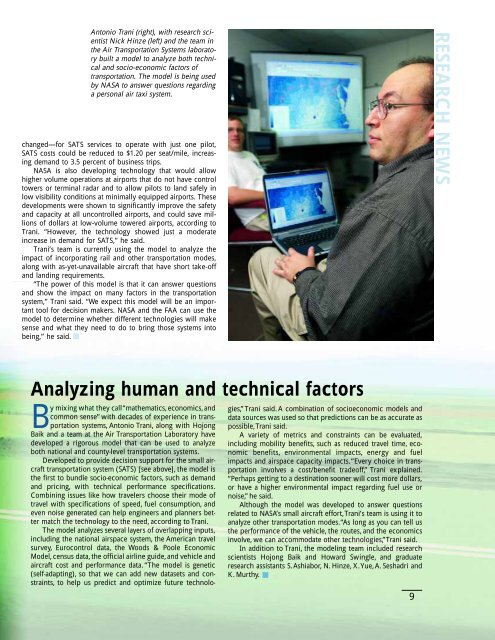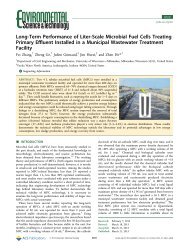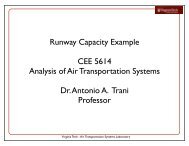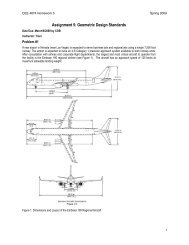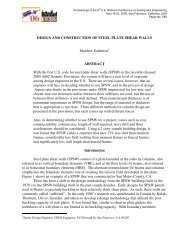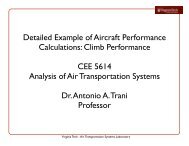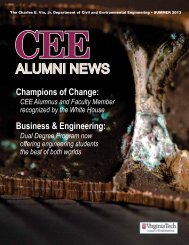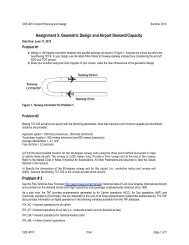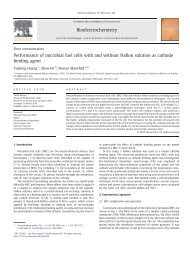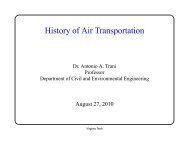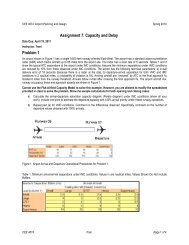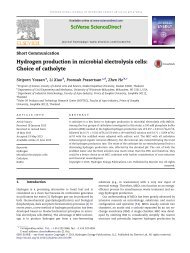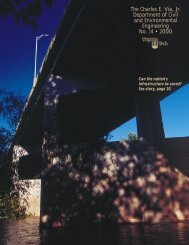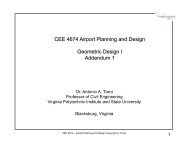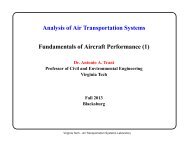Annual Report Year 2004 - Civil and Environmental Engineering
Annual Report Year 2004 - Civil and Environmental Engineering
Annual Report Year 2004 - Civil and Environmental Engineering
- No tags were found...
Create successful ePaper yourself
Turn your PDF publications into a flip-book with our unique Google optimized e-Paper software.
Antonio Trani (right), with research scientistNick Hinze (left) <strong>and</strong> the team inthe Air Transportation Systems laboratorybuilt a model to analyze both technical<strong>and</strong> socio-economic factors oftransportation. The model is being usedby NASA to answer questions regardinga personal air taxi system.changed—for SATS services to operate with just one pilot,SATS costs could be reduced to $1.20 per seat/mile, increasingdem<strong>and</strong> to 3.5 percent of business trips.NASA is also developing technology that would allowhigher volume operations at airports that do not have controltowers or terminal radar <strong>and</strong> to allow pilots to l<strong>and</strong> safely inlow visibility conditions at minimally equipped airports. Thesedevelopments were shown to significantly improve the safety<strong>and</strong> capacity at all uncontrolled airports, <strong>and</strong> could save millionsof dollars at low-volume towered airports, according toTrani. “However, the technology showed just a moderateincrease in dem<strong>and</strong> for SATS,” he said.Trani’s team is currently using the model to analyze theimpact of incorporating rail <strong>and</strong> other transportation modes,along with as-yet-unavailable aircraft that have short take-off<strong>and</strong> l<strong>and</strong>ing requirements.“The power of this model is that it can answer questions<strong>and</strong> show the impact on many factors in the transportationsystem,” Trani said. “We expect this model will be an importanttool for decision makers. NASA <strong>and</strong> the FAA can use themodel to determine whether different technologies will makesense <strong>and</strong> what they need to do to bring those systems intobeing,” he said.RESEARCH NEWSAnalyzing human <strong>and</strong> technical factorsBy mixing what they call “mathematics,economics,<strong>and</strong>common sense” with decades of experience in transportationsystems, Antonio Trani, along with HojongBaik <strong>and</strong> a team at the Air Transportation Laboratory havedeveloped a rigorous model that can be used to analyzeboth national <strong>and</strong> county-level transportation systems.Developed to provide decision support for the small aircrafttransportation system (SATS) [see above], the model isthe first to bundle socio-economic factors, such as dem<strong>and</strong><strong>and</strong> pricing, with technical performance specifications.Combining issues like how travelers choose their mode oftravel with specifications of speed, fuel consumption, <strong>and</strong>even noise generated can help engineers <strong>and</strong> planners bettermatch the technology to the need, according to Trani.The model analyzes several layers of overlapping inputs,including the national airspace system, the American travelsurvey, Eurocontrol data, the Woods & Poole EconomicModel, census data, the official airline guide, <strong>and</strong> vehicle <strong>and</strong>aircraft cost <strong>and</strong> performance data. “The model is genetic(self-adapting), so that we can add new datasets <strong>and</strong> constraints,to help us predict <strong>and</strong> optimize future technolo-gies,”Trani said. A combination of socioeconomic models <strong>and</strong>data sources was used so that predictions can be as accurate aspossible,Trani said.A variety of metrics <strong>and</strong> constraints can be evaluated,including mobility benefits, such as reduced travel time, economicbenefits, environmental impacts, energy <strong>and</strong> fuelimpacts <strong>and</strong> airspace capacity impacts.“Every choice in transportationinvolves a cost/benefit tradeoff,” Trani explained.“Perhaps getting to a destination sooner will cost more dollars,or have a higher environmental impact regarding fuel use ornoise,” he said.Although the model was developed to answer questionsrelated to NASA’s small aircraft effort,Trani’s team is using it toanalyze other transportation modes.“As long as you can tell usthe performance of the vehicle, the routes, <strong>and</strong> the economicsinvolve, we can accommodate other technologies,”Trani said.In addition to Trani, the modeling team included researchscientists Hojong Baik <strong>and</strong> Howard Swingle, <strong>and</strong> graduateresearch assistants S.Ashiabor, N. Hinze, X.Yue,A. Seshadri <strong>and</strong>K. Murthy.9


